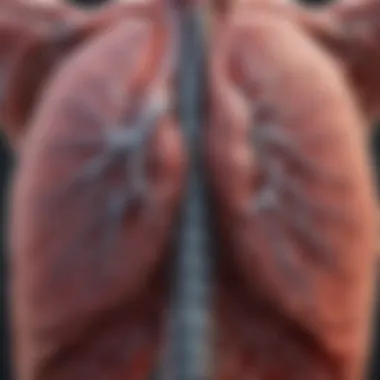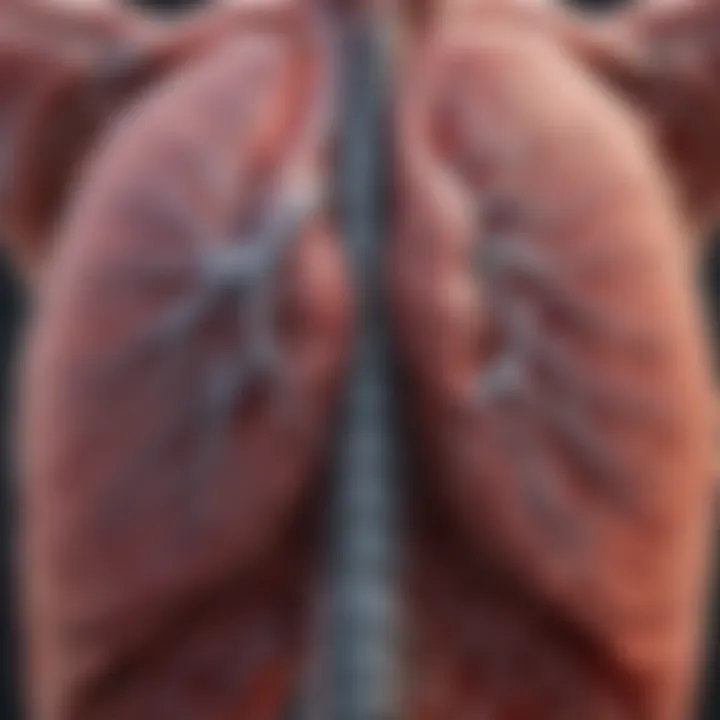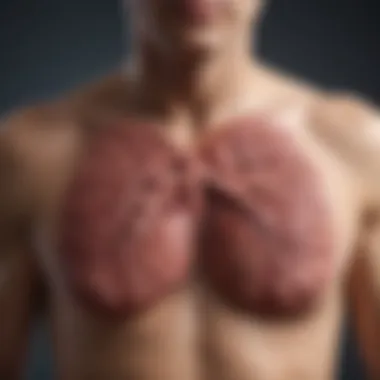Understanding Bullous Lung Disease: Key Insights


Intro
Bullous lung disease, though not commonly discussed, deserves careful attention due to its impact on respiratory function. This condition manifests through the formation of large air-filled spaces, known as bullae, within the lung tissue. Understanding this condition is vital for healthcare professionals and individuals with a vested interest in pulmonary health.
In this article, we provide a comprehensive exploration of bullous lung disease, including its causes, effects on lung structure, diagnosis, and treatment options available. Along the way, we will also touch upon the role of risk factors such as smoking, and how these influences complicate management strategies for affected patients.
In doing so, we aim to equip readers with a thorough understanding of the implications of this disease, offering practical insights for better patient care. As we delve into the complexities of bullous lung disease, it is essential to grasp the key concepts and terminology surrounding this condition.
Foreword to Bullous Lung Disease
Bullous lung disease is an important topic that requires in-depth discussion due to its implications for respiratory health. The presence of large air-filled spaces, known as bullae, in the lung tissue can lead to significant impairments in lung function. Understanding this condition can aid in early detection, improve treatment outcomes, and guide healthcare professionals in managing patients effectively.
With a focus on the various aspects of bullous lung disease, this article presents a structured overview. It delves into definitions, epidemiology, pathophysiological changes, causes, symptoms, diagnostic methods, treatment options, and prognostic factors. Each section highlights relevant insights that are critical for students, researchers, and healthcare professionals. Not only does the article aim to inform on what bullous lung disease is, but it also emphasizes the importance of awareness regarding this condition. This is vital for promoting preventative measures and treatments among affected individuals.
Definition and Overview
Bullous lung disease is characterized by the formation of large air spaces within the lungs, which can disrupt normal respiratory function. These air-filled structures develop as a result of localized destruction of lung tissue, leading to compromised respiratory mechanics. Among the various types of pulmonary conditions, bullous lung disease presents unique challenges and complications that warrant a careful understanding.
Symptoms may range from mild to severe and can affect everyday life, thereby necessitating proper management and intervention. A clear definition of the disease serves as a foundation for understanding its implications for a patient’s health and quality of life.
Epidemiology
The epidemiology of bullous lung disease reflects its relevance in public health. It is important to understand how common this condition is and which populations are most affected. Studies show that bullous lung disease can occur in individuals with various risk factors, predominantly among populations with a history of smoking.
Research suggests that this condition is more prevalent in older adults, particularly those aged over 50. However, it is essential to note that younger populations can also develop bullous lung disease, especially due to genetic factors or other lung injuries.
In various studies, the prevalence rate of bullous lung disease has been estimated at 3% to 5% among chronic obstructive pulmonary disease (COPD) patients.
Understanding the characteristics of demographics affected by bullous lung disease can inform the development of targeted prevention and treatment strategies.
Pathophysiology of Bullous Lung Disease
The pathophysiology of bullous lung disease is critical for comprehending how this condition affects respiratory health. Understanding the biological mechanisms and structural changes that occur in the lungs can aid in diagnosing and managing the disease effectively. Knowledge in this area is particularly vital for healthcare professionals engaged in the treatment of individuals suffering from respiratory conditions. Through this section, we will delve into the anatomical changes in the lungs and investigate the mechanism of bullae formation, two aspects that are pivotal to grasping the full scope of bullous lung disease.
Anatomical Changes in the Lungs
In bullous lung disease, one of the primary anatomical changes involves the destruction of the lung parenchyma. This leads to the formation of large air-filled spaces, known as bullae. These bullae can vary in size, ranging from a few millimeters to several centimeters.
The progressive destruction of the alveolar structures accounts for the compromised gas exchange capacity of the lungs. The alveoli, which are the tiny air sacs responsible for oxygen and carbon dioxide exchange, become enlarged and lose their natural elasticity. This results in a decrease in the surface area available for gas exchange. Consequently, patients may experience significant respiratory distress, decreased exercise tolerance, and reduced quality of life.
Moreover, structural changes also include the weakening of the lung architecture. It is not only the alveoli that are impacted; the surrounding tissues, including connective tissue and blood vessels, can also undergo alterations. These changes can lead to increased compliance during the early phases of the disease, but eventually, respiratory function deteriorates over time.
The following are key points to consider regarding anatomical changes:
- Destruction of the alveolar walls
- Formation of bullae of varrying sizes
- Decreased surface area for gas exchange
- Compromised lung elasticity
Mechanism of Bullae Formation
The mechanism behind bullae formation is multifaceted and involves several pathophysiological processes. The most common contributor is emphysema, often associated with chronic obstructive pulmonary disease (COPD). In emphysematous changes, the balance between proteases and antiproteases is disrupted, leading to increased tissue breakdown in the lungs.
This proteolytic degradation is often exacerbated by environmental factors like smoking or exposure to pollutants. Smoking leads to the influx of inflammatory cells into the lung tissue, which in turn releases various enzymes that break down elastin and collagen. The destruction of these components weakens the alveolar walls and promotes the coalescence of smaller alveoli into larger bullae. This merging process not only enlarges the air-filled spaces but also compromises the structural integrity of the lung tissues.
Other mechanisms that have been cited include genetic factors, particularly the deficiency of alpha-1 antitrypsin, a protein that protects elastin from being broken down. Those with this deficiency are at an increased risk for developing bullous lung disease at a younger age.
Key mechanisms involved in bullae formation are:
- Protease-antiprotease imbalance
- Inflammatory cell infiltration
- Enzymatic degradation of lung tissue
- Genetic predisposition


A thorough understanding of the anatomical and mechanistic changes in bullous lung disease can inform targeted treatment strategies, ultimately improving patient outcomes.
In summary, recognizing the pathophysiology of bullous lung disease provides essential insights necessary for diagnosing, managing, and treating patients effectively. The interplay of various elements in both anatomical changes and the mechanism of bullae formation underscores the complexity of this condition.
Causes and Risk Factors
Understanding the causes and risk factors of bullous lung disease is essential for multiple reasons. First, recognizing these elements can enable earlier diagnosis and intervention. Second, by identifying modifiable risk factors, patients can adjust their lifestyles to mitigate further lung damage. This section elaborates on the primary causes, environmental influences, and genetic factors associated with bullous lung disease.
Primary Causes
Bullous lung disease may arise from different primary causes. The most notable of these is chronic obstructive pulmonary disease (COPD). This disease leads to lung tissue damage due to prolonged inflammation, ultimately causing the formation of bullae—large air-filled spaces that replace healthy lung tissue. Additionally, pulmonary emphysema, a subtype of COPD, is specifically recognized for its direct association with bullae.
Other significant causes include viral infections. Some viral infections can lead to lung damage, increasing vulnerability to bullous formation. Aging also plays a role, as the elasticity and regenerative capacity of lung tissue diminish over time, making the lungs more susceptible to damage.
Environmental Influences
Environmental factors significantly impact the development of bullous lung disease. Cigarette smoking stands as the most important influence. Tobacco smoke exposes lung tissues to harmful substances, leading to inflammation and damage. This exposure results in the degradation of elastic lung tissues, promoting bullae formation.
Yet smoking is not the only environmental influence. Air pollution, including particulates and chemical inhalants, can irritate lung tissues. Occupational exposures, such as those found in construction or manufacturing, to harmful substances can also contribute to lung damage. It is necessary to consider places with high pollution levels as potential areas for increased risk of developing this condition.
Genetic Factors
Genetic predispositions add another layer to understanding bullous lung disease. Certain individuals may inherit conditions that affect lung function. One such hereditary disorder is alpha-1 antitrypsin deficiency. This condition leads to inadequate levels of a protein that protects the lungs from damage. Without this protection, individuals become more susceptible to developing emphysema and, consequently, bullae.
Moreover, a family history of lung diseases can signal a higher risk for bullous lung disease. Genetic variations may affect how individuals respond to environmental factors, making some people more vulnerable than others.
"Genetic factors, combined with environmental exposures, create a complex interplay that influences the risk of developing bullous lung disease."
Symptoms and Clinical Manifestations
Understanding symptoms and clinical manifestations is crucial in managing bullous lung disease. Identifying these signs is the first step toward effective treatment and improving patient quality of life. The symptoms can be subtle or pronounced, making awareness essential for patients and healthcare providers. This section explores common and advanced clinical features associated with this condition.
Common Symptoms
The common symptoms of bullous lung disease often include:
- Shortness of breath: This is typically the most noticeable symptom. Patients may struggle with dyspnea even during light activities, limiting their functional capacity.
- Chronic cough: A persistent cough may develop as the lungs respond to damage. The cough can be dry or produce sputum, depending on other underlying conditions.
- Chest pain: Some patients report discomfort or pain in the chest. This pain can result from the stretching and pressure caused by bullae on surrounding tissue.
- Wheezing: This symptom results from narrowed airways, which can be a complication of lung damage.
- Fatigue: The effort required to breathe may lead to increased fatigue, affecting daily activities and overall health.
These symptoms can vary in severity. Early recognition and diagnosis are important, as untreated symptoms can progress.
Advanced Clinical Features
As the disease progresses, several advanced clinical features may emerge. These are often indicative of more severe pulmonary impairment:
- Respiratory failure: In severe cases, the lungs may fail to provide adequate oxygen to the body, necessitating assistance through oxygen therapy or mechanical ventilation.
- Cyanosis: This bluish discoloration of the skin, particularly around the lips and fingertips, can indicate low oxygen levels in the blood.
- Frequent respiratory infections: Patients may experience an increased incidence of bronchitis and pneumonia due to impaired lung function.
- Cor pulmonale: This condition, characterized by right-sided heart failure, can develop from chronic low oxygen levels, further complicating patient outcomes.
It is advisable for anyone experiencing these advanced symptoms to seek medical evaluation promptly. Early intervention can significantly alter the disease course and improve the prognosis.
Recognizing and understanding both common and advanced symptoms of bullous lung disease is vital in ensuring timely and effective care.
Diagnosis of Bullous Lung Disease
The diagnosis of bullous lung disease is equally crucial as understanding its causes and treatment. An accurate and timely diagnosis can significantly influence patient outcomes. The identification of the disease relies on diverse methodologies that help to reveal the underlying pulmonary abnormalities. Without an appropriate diagnosis, managing the condition effectively becomes difficult, making this section essential to the broader discussion on bullous lung disease.


Clinical Evaluation
Clinical evaluation serves as the cornerstone for diagnosing bullous lung disease. It begins with a thorough patient history. This involves gathering information about symptoms such as shortness of breath, cough, and chest pain. Doctors must consider the duration and progression of these symptoms. It is also important to note any family history of lung diseases or the patient's exposure to relevant risk factors, such as smoking.
During the physical examination, healthcare providers will assess the patient’s respiratory rate and effort. They often listen for abnormal lung sounds, which may indicate the presence of bullae. A pulse oximeter can also be used to check blood oxygen levels, providing further insights into the respiratory function. In many cases, clinical evaluation alone is not sufficient for a definitive diagnosis.
Imaging Techniques
Imaging techniques play an essential role in the accurate diagnosis of bullous lung disease. High-resolution computed tomography (CT) scans are among the most effective methods for visualizing lung structures. CT scans can reveal the size and distribution of bullae, differentiating them from other lung conditions.
Chest X-rays may also be performed. However, while they can show large bullae, they are often less detailed than CT scans. In more complex cases, additional imaging, such as magnetic resonance imaging (MRI), might be used, although this is rare in pulmonary diagnostics.
Key Point: Imaging allows clinicians to not only confirm the presence of bullae but also to evaluate their potential impact on lung function and guide subsequent treatment strategies.
Pulmonary Function Tests
Pulmonary function tests (PFTs) provide valuable information about lung function and are often included in the diagnostic process for bullous lung disease. These tests measure various aspects of lung performance, including how much air the lungs can hold and how quickly air can be exhaled.
The results of PFTs help determine the disease's severity and guide treatment. Common tests may include spirometry, which measures the volume and speed of air that can be forcibly exhaled. Another test is the diffusion capacity test, which assesses how efficiently oxygen passes from the lungs into the bloodstream.
These tests can show a decrease in lung capacity and airflow limitation, characteristic of bullous lung disease. Overall, they offer essential insight that complements clinical evaluations and imaging findings.
Treatment Options
Treatment options for bullous lung disease are essential for managing symptoms and improving patient quality of life. The approach to treating this condition varies based on the underlying causes, severity of symptoms, and overall health status of the patient. An effective management plan may combine various interventions, tailored to the individual needs of each patient. Here, we will discuss the primary treatment modalities, including pharmacological interventions, surgical approaches, and rehabilitation options.
Pharmacological Interventions
Pharmacological interventions primarily focus on alleviating symptoms and preventing exacerbations. Commonly used medications include bronchodilators, corticosteroids, and antibiotics.
- Bronchodilators help to relax and open the airways, improving airflow and reducing breathlessness. These medications are often first-line treatments for patients with respiratory distress.
- Corticosteroids may be employed to reduce inflammation in the lungs. They can improve lung function and overall endurance, particularly during flare-ups.
- Antibiotics are critical when treating secondary infections that may arise as a result of compromised lung function. Prompt treatment of these infections can prevent severe complications.
It's crucial for healthcare providers to monitor patients closely when initiating pharmacotherapy, adjusting dosages as needed to balance efficacy and side effects. This careful management can lead to significant improvements in respiratory health and daily function.
Surgical Approaches
In severe cases of bullous lung disease, surgical intervention can be necessary. Surgical options typically include bullectomy, which involves the removal of large bullae, or lung volume reduction surgery.
- Bullectomy is indicated when bullae are large and impair lung function. By removing these spaces, lung capacity can be significantly improved, leading to better overall respiratory function.
- Lung volume reduction surgery is more complex and is reserved for patients with severe, emphysematous changes. This surgery aims to remove diseased sections of the lung, allowing healthier tissue to expand and function effectively.
Lung resection surgeries are not without risks; complications such as infection or respiratory failure can occur. Therefore, careful patient selection and pre-operative evaluation are crucial.
Rehabilitation and Supportive Care
Rehabilitation is an integral part of the management plan for bullous lung disease. This approach focuses on improving lung function and physical endurance.
- Pulmonary rehabilitation programs combine physical exercises with education about lung disease. This dual approach helps patients understand how to manage their symptoms while improving stamina.
- Oxygen therapy may be required for individuals experiencing significant hypoxemia. This treatment can alleviate breathlessness and enhance quality of life.
Supportive care also encompasses addressing psychological well-being. Anxiety and depression can arise from chronic respiratory illness, making mental health support essential. Patients may benefit from counseling and support groups, fostering coping strategies and shared experiences.
In summary, treatment options for bullous lung disease must be comprehensive and tailored to each individual's needs. Collaboration among specialists—pulmonologists, surgeons, and rehabilitation experts—ensures a holistic approach, ultimately aiming for improved outcomes and enhanced quality of life for patients.
Prognosis and Outcomes


Prognosis and outcomes play a vital role in the management of bullous lung disease. Understanding the prognosis can help healthcare professionals make informed decisions regarding treatment, monitoring, and patient education. It also establishes expectations for patients and their families about the disease progression.
The prognosis varies significantly across individuals. Factors such as the underlying cause of the bullous lung disease, the extent of lung damage, concurrent health conditions, and the patient’s overall health status all contribute to the outcome. By analyzing these elements, clinicians can tailor strategies to improve patient results.
"Understanding prognosis is essential in optimizing management strategies tailored to individual patient needs."
Factors Influencing Prognosis
Several factors influence the prognosis of bullous lung disease. These include:
- Cause of the Disease: Conditions like emphysema or cystic fibrosis have distinct prognoses. Identifying the underlying cause helps in predicting disease behavior.
- Severity of Bullae: The size and number of bullae present in the lungs can indicate the severity of the condition. Larger or multiple bullae can lead to greater respiratory compromise.
- Comorbidities: The presence of other health issues such as heart disease, diabetes, or chronic obstructive pulmonary disease (COPD) can negatively impact the prognosis. Comorbidities often complicate treatment and management.
- Smoking Habits: Continued smoking can significantly worsen lung function and accelerate disease progression. Quitting smoking is crucial for improving overall health outcomes.
- Age and Gender: Older age is typically associated with a poorer prognosis. Gender may also play a role, as certain studies suggest differing outcomes between men and women.
Long-Term Management Strategies
Long-term management strategies for patients with bullous lung disease must be comprehensive and personalized to enhance quality of life and prognosis. Key approaches include:
- Regular Monitoring: Routine follow-ups with healthcare providers allow for timely adjustments in treatment plans based on disease progression.
- Smoking Cessation: For diagnosed patients who smoke, implementing effective cessation programs can reduce further deterioration of lung function.
- Pulmonary Rehabilitation: Engaging in structured rehabilitation programs can improve physical capacity and respiratory health.
- Medical Management: Pharmacotherapy, such as bronchodilators and corticosteroids, can help manage symptoms and improve lung function.
- Surgical Options: In cases of severe bullous disease, surgical interventions such as bullectomy may improve breathing and lung capacity.
- Education and Support: Educating patients about their disease and symptoms plays a crucial role in self-management. Support systems including counseling and peer groups are beneficial.
Overall, effective long-term management can significantly influence the prognosis and daily life of patients with bullous lung disease. Therefore, a holistic approach that combines medical treatment, lifestyle changes, and patient education is essential to optimize outcomes.
Culmination
The conclusion of this article plays a crucial role in encapsulating the primary elements related to bullous lung disease. It synthesizes the information presented throughout the text, emphasizing the importance of understanding the complexities of this pulmonary condition. By highlighting the multifaceted nature of the disease, this section serves to reinforce the necessity of a comprehensive approach to diagnosis and treatment, especially in the context of patient management.
Summary of Key Points
In summary, bullous lung disease encompasses a range of significant aspects:
- Definition and Overview: This condition is marked by the presence of bullae, which are abnormal air-filled spaces in the lungs.
- Pathophysiology: The anatomical and physiological changes highlight the mechanisms of bullae formation, underlying the disease's progression.
- Causes and Risk Factors: Smoking, environmental hazards, and genetic predispositions contribute substantially to the development of this disease.
- Symptoms and Clinical Manifestations: Patients typically experience specific symptoms and clinical features that reflect the severity and advancement of the condition.
- Diagnosis: Effective diagnosis is achieved through a thorough clinical evaluation, advanced imaging techniques, and pulmonary function tests.
- Treatment Options: A variety of pharmacological and surgical interventions, along with rehabilitation, are essential for managing the disease.
- Prognosis and Outcomes: Understanding the prognosis is vital for long-term management and improving patient quality of life.
This succinct summary reminds the audience of the critical aspects of bullous lung disease, elucidating both the challenges and strategies related to its management.
Future Directions in Research
Future research on bullous lung disease should focus on several pivotal areas:
- Novel Therapeutic Strategies: Exploration of innovative treatment options could lead to more effective management and improved patient outcomes.
- Genetic and Biomolecular Research: Identifying genetic markers associated with the disease could enhance early diagnosis and tailor personal treatment plans.
- Longitudinal Studies: Conducting long-term studies can provide insights into the progression of the disease and the efficacy of different interventions over time.
- Patient-Centric Approaches: Emphasizing patient quality of life as a primary outcome in clinical research may yield valuable data that informs future healthcare policies.
Investing in these research avenues will provide deeper insights into bullous lung disease, informing clinical practice and enhancing health care strategies. This focus on research is essential for the next generation of practitioners and researchers dedicated to improving the understanding and management of this pressing health issue.
Importance of References
The importance of references in this article can be summarized in several key aspects:
- Validation of Information: Accurate references back up claims, making it easier for readers to trust the data presented. For example, statistics about the prevalence of bullous lung disease should be sourced from credible epidemiological studies or health organization databases.
- Further Reading: References allow interested readers to delve deeper into the subject. By providing links to peer-reviewed journals, books, and authoritative websites, the article fosters a culture of continuous learning and inquiry.
- Guidance for Practitioners: Healthcare professionals may seek specific guidance on treatment protocols or management strategies. Referencing clinical guidelines and studies can direct them to valuable resources that enhance their practice.
- Interdisciplinary Collaboration: Bullous lung disease involves aspects of pulmonology, genetics, and environmental health. References can bridge these fields, helping educators and researchers connect their work to broader contexts and discussions.
Considerations for Adequate Referencing
When referencing works in a scientific article, several considerations must be accounted for:
- Recency and Relevance: It is essential to ensure that references are up to date, particularly in areas where research is rapidly progressing. Older studies, while still valuable, should be balanced with recent findings.
- Diversity of Sources: A well-rounded reference list should include a mix of studies, reviews, and clinical guidelines from various backgrounds. This not only provides a comprehensive view but also mitigates potential biases from singular sources.
- Formatting: Consistency in formatting references enhances readability. Whether utilizing APA, MLA, or another citation style, adhering to set guidelines is necessary to maintain professionalism.
End
In summary, references are integral to the construction of a meaningful and trustworthy article on bullous lung disease. They contribute to the overall quality of the writing, ensuring that it serves as a valuable resource for students, researchers, educators, and healthcare professionals. By grounding the content in reliable sources, we not only inform our readers but also empower them with the knowledge needed to further explore this complex disease.
"Quality references enrich the discourse around bullous lung disease, fostering informed decision-making in both academic and clinical settings."
For more information, readers may explore entries on Wikipedia, Britannica, or forums on Reddit.







